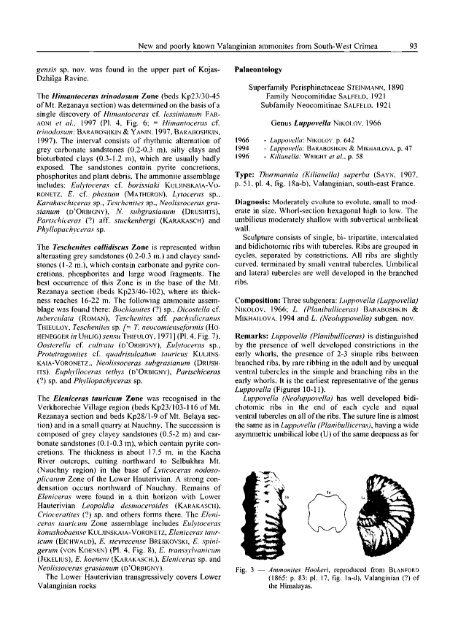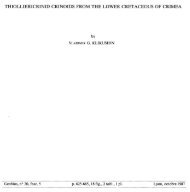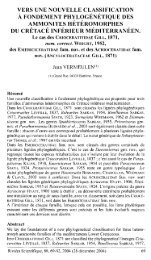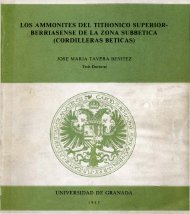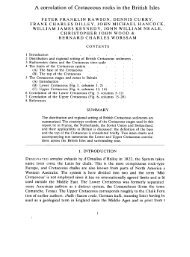New and poorly known Valanginian ammonites from South-West ...
New and poorly known Valanginian ammonites from South-West ...
New and poorly known Valanginian ammonites from South-West ...
You also want an ePaper? Increase the reach of your titles
YUMPU automatically turns print PDFs into web optimized ePapers that Google loves.
<strong>New</strong> <strong>and</strong> <strong>poorly</strong> <strong>known</strong> <strong>Valanginian</strong> <strong>ammonites</strong> <strong>from</strong> <strong>South</strong>-<strong>West</strong> Crimea 93gensis sp. nov. was found in the upper part of Kojas-Dzhilga Ravine.The Himantoceras trinodosum Zone (beds Kp23/30-45of Mt, Rezanaya section) was determined on Ihe basis of asingle discovery of Himantoceras cf. lessinianum FAR-AONI et al, 1997 (PI. 4, Fig. 6; = Himantoceras cf.trinodosum: BARABOSHKIN & YANIN. 1997, BARABOSHKIN.1997). The interval consists of rhythmic alternation ofgrey carbonate s<strong>and</strong>stones (0.2-0.3 m), silty clays <strong>and</strong>bioturbated clays (0.3-1.2 m), which are usually badlyexposed. The s<strong>and</strong>stones contain pyrite concretions,phosphorites <strong>and</strong> plant debris. The ammonite assemblageincludes: Eulytoceras cf. borissiakJ KULJINSKAIA-VO-RONETZ, E. cf. phestum (MATHERON), Lytoceras sp,.Karaka.se/iiceras sp., Teschenites sp., Neotissoceras grasianum(D'ORBIGNY), N. subgrasianum (DRUSHITS),Partschiceras (?) aff. stuckenbergi (KARAKASCH) <strong>and</strong>Phyltopachyceras sp.The Teschenites callidiscus Zone is represented withinalternating grey s<strong>and</strong>stones (0.2-0.3 m.) <strong>and</strong> clayey s<strong>and</strong>stones(I -2 m.), which contain carbonate <strong>and</strong> pyrite concretions,phosphorites <strong>and</strong> large wood fragments. Thebest occurrence of this Zone is in the base of the Mt.Rezanaya section (beds Kp23/46-102), where its thicknessreaches 16-22 m. The following ammonite assemblagewas found there: Bochianites (?) sp., Dicostella cf.lubercitlato (ROMAN), Teschenites aff pachydicranusTHIEULOV. Teschenites sp. [- T. neocomienseformis (Ho-HENEGGER in UHLIG)sensuTHIEULOY, 1971] (PI. 4, Fig. 7),Oosterella cf. cultrata (D'ORBIGNY), Eulytoceras sp.,Protetragonites cf. quadrisulcatum tauricus KULJINS-KAIA-VORONETZ., Neolissoceras subgrasianum (DRLJSH-ITS). EuphyUoceras tethys (D'ORBIGNY), Partschiceras(?) sp. <strong>and</strong> Pfiyllopachyceras sp.The Eleniceras tauricum Zone was recognised in theVerkhorechie Village region (beds Kp23/103-116 of Mt.Rezanaya section <strong>and</strong> beds Kp28/l-9 of Mt. Belaya section)<strong>and</strong> in a small quarry at Nauchny. The succession iscomposed of grey clayey s<strong>and</strong>stones (0.5-2 m) <strong>and</strong> carbonates<strong>and</strong>stones (0.1-0.3 m), which contain pyrite concretions.The thickness is about 17.5 m. in the KachaRiver outcrops, cutting northward to Selbukhra Mt.(Nauchny region) in the base of Lyticoceras nodosoplieatumZone of the Lower Hauterivian. A strong condensationoccurs northward of Nauchny. Remains ofEleniceras were found in a thin horizon with LowerHauterivian Leopotdia desmoceroides (KARAKASCH),Crioceratites (?) sp. <strong>and</strong> others forms there. The Elenicerastauricum Zone assemblage includes Eulytoceraskonushobaense KULJINSKAIA-VORONETZ, Eleniceras tauricum(ElCHWALD), E. stevrecense BRESKOVSKI, E. spinigerum(VON KOENEN) (PI. 4, Fig. 8), E. transsyivanicum(JEKELIUS), E. koeneni (KARAKASCH.), Eleniceras sp. <strong>and</strong>Neolissoceras grasianum (D'ORBIGNY).The Lower Hauterivian transgressively covers Lower<strong>Valanginian</strong> rocksPalaeontologySuperfamily Perisphinctaceae STEINMANN, 1890Family Neocomitidae SALFELD, 1921Subfamily Neocomitinae SALFELD. 1921Genus Luppovella NIKOI.OV, 19661966 - Luppovella: NIKOLOV. p. 6421994 - Luppovella: BARABOSHKIN & MIKHAILOVA, p. 471996 - Kitianella: WRIGHT et al., p. 58Type: Thurmamiia (Kitianella) superba (SAYN, 1907,p. 51, pi. 4, fig. I8a-b), <strong>Valanginian</strong>, south-east France.Diagnosis: Moderately evolute to evolute, small to moderatein size. Whorl-section hexagonal high to low. Theumbilicus moderately shallow with subvertical umbilicalwall.Sculpture consists of single, bi- tripartite, intercalated<strong>and</strong> bidichotomic ribs with tubercles. Ribs are grouped incycles, separated by constrictions. All ribs are slightlycurved, terminated by small ventral tubercles. Umbilical<strong>and</strong> lateral tubercles are well developed in the branchedribs.Composition: Three subgenera: Luppovella(Luppovella,)NIKOLOV, 1966; L. (Planibulliceras) BARABOSHKIN &MIKHAILOVA. 1994 <strong>and</strong> L. (Neoluppovella) subgen. nov.Remarks: Luppovella (Planibulliceras) is distinguishedby the presence of well developed constrictions in theearly whorls, the presence of 2-3 simple ribs betweenbranched ribs, by rare ribbing in the adult <strong>and</strong> by unequalventral tubercles in the simple <strong>and</strong> branching ribs in theearly whorls. It is the earliest representative of the genusLuppovella (Figures 10-11).Luppovella (Neoluppovella) has well developed bidichotomicribs in the end of each cycle <strong>and</strong> equalventral tubercles on all of the ribs. The suture line is almostthe same as in Luppovella (Planibulliceras), having a wideasymmetric umbilical lobe (U) of the same deepness as forFig. 3 — Ammonites Hookeri, reproduced <strong>from</strong> BLANFOHO(1865: p. 83: pi. 17. fig. 1a-d>, <strong>Valanginian</strong> (?) ofthe Himalayas.


